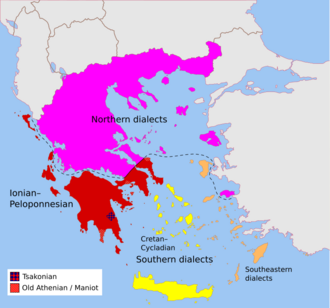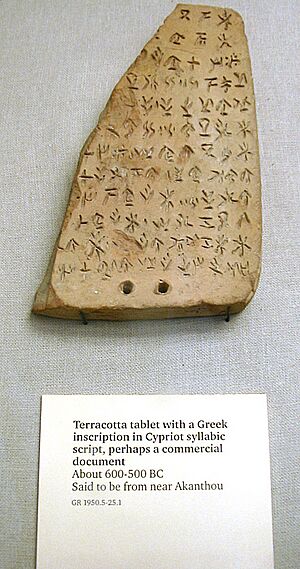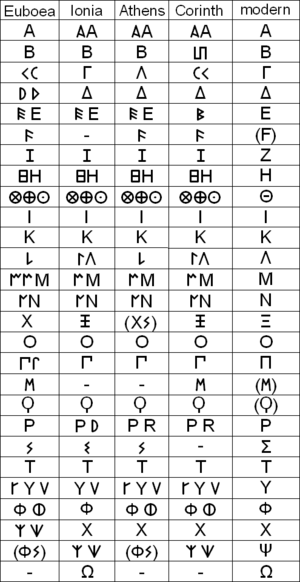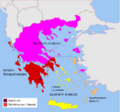Greek language facts for kids
Quick facts for kids Greek |
||||
|---|---|---|---|---|
| Ελληνικά Elliniká |
||||
| Native to |
|
|||
| Ethnicity | Greeks | |||
| Native speakers | 13.5 million (2012)e18 | |||
| Language family |
Indo-European
|
|||
| Early forms: |
Proto-Greek
|
|||
| Dialects |
Ancient dialects
Modern dialects
|
|||
| Writing system | Greek alphabet | |||
| Official status | ||||
| Official language in | ||||
| Recognised minority language in | ||||
| Linguasphere |
|
|||
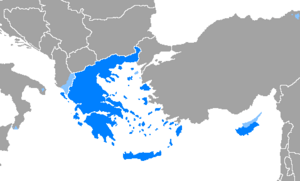
Areas where Modern Greek is spoken (Dark blue represents areas where it is the official language.)
|
||||
|
||||
Greek (Modern Greek: Ελληνικά, romanized: Elliniká Ancient Greek: Ἑλληνική, romanized: Hellēnikḗ) is a very old language from the Indo-European language family. It forms its own unique branch called Hellenic. People mainly speak Greek in Greece, Cyprus, parts of Italy (like Calabria and Salento), southern Albania, and other areas around the Balkans, Caucasus, Black Sea coast, Asia Minor, and the Eastern Mediterranean.
Greek has the longest recorded history of any Indo-European language. We have written records of Greek going back at least 3,400 years! The Greek alphabet has been used for about 2,800 years. Before that, Greek was written using systems like Linear B and the Cypriot syllabary. The Greek alphabet came from the Phoenician script. It then became the basis for many other writing systems, including Latin, Cyrillic, and Coptic.
The Greek language is super important in the history of the Western world. Famous ancient Greek writers like Homer created amazing stories that are still read today. Many important ideas in science and philosophy were first written in Greek. Even the New Testament of the Christian Bible was originally written in Greek. Studying ancient Greek texts and societies, along with Roman ones, is part of a field called Classics.
Long ago, during ancient times, Greek was a very common language spoken across the Mediterranean world. It later became the official language of the Byzantine Empire. Today, Greek is the official language of Greece and Cyprus. It is also one of the 24 official languages of the European Union. About 13.5 million people speak Greek in Greece, Cyprus, Italy, Albania, Turkey, and many other countries where Greeks live.
Greek words and parts of words are often used to create new words in other languages. For example, many scientific words in English come from Greek and Latin.
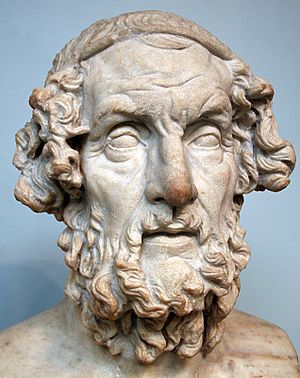
Contents
The Story of Greek: A Long Journey
Greek has been spoken in the Balkan peninsula since around 3000 BC, or maybe even earlier. The oldest written proof of Greek is a Linear B clay tablet found in Messenia. It dates back to between 1450 and 1350 BC. This makes Greek the oldest recorded living language in the world!
Different Eras of the Greek Language
The Greek language has changed over time. Experts divide its history into different periods:
- Proto-Greek: This is the very first form of Greek, but we don't have any written records of it. It's believed that this language started to split into different forms when Greek-speaking people moved into the Greek peninsula long ago.
- Mycenaean Greek: This was the language used by the Mycenaean civilization. We know about it from Linear B tablets, which are clay tablets with writing from the 15th century BC.
- Ancient Greek: This includes the different dialects spoken during the Archaic and Classical periods of ancient Greek civilization. It was well-known throughout the Roman Empire. While it wasn't used much in Western Europe during the Middle Ages, it remained the official language in the Byzantine world.
- Koine Greek (also called Hellenistic Greek): This was a common Greek language that developed from a mix of dialects. It became a language used by many people across the Eastern Mediterranean and Near East. Alexander the Great's armies helped spread Koine Greek. It was spoken from Egypt all the way to parts of India. Because it was so widely used, rules were made for how to use it correctly. The New Testament of the Christian Bible was originally written in Koine Greek.
- Medieval Greek (also known as Byzantine Greek): This is the Greek language used during the Byzantine Empire, which lasted until the 15th century. It was a continuation of Koine Greek.
- Modern Greek (also known as Neo-Hellenic): This is the language spoken by Greeks today. It developed from Medieval Greek, with some changes appearing as early as the 11th century. There are also several dialects of Modern Greek.
The Greek Language Question
In modern times, Greek had two main forms:
- Dimotiki: This was the everyday, spoken form of Modern Greek.
- Katharevousa: This was a more "purified" form, created in the early 1800s. It was a mix of Dimotiki and Ancient Greek and was used for official and literary purposes.
This situation was called the "Greek language question." In 1976, Dimotiki became the official language of Greece. It had taken on some features from Katharevousa, leading to what we now call Standard Modern Greek. This is the language used for all official purposes and in schools today.
A Language That Stays Connected
People often point out how connected the different stages of the Greek language are. Even though Greek has changed over time, its cultural, literary, and writing traditions have never really been broken. Greek speakers today still feel that ancient Greek writings are part of their own language, not a foreign one. Some even say that Homeric Greek (from ancient times) is closer to today's Greek than 12th-century English is to modern English!
Where Greek is Spoken Today
Today, at least 13 million people speak Greek. Most of them live in Greece and Cyprus. There's also a good number of Greek speakers in Albania, especially near the border with Greece. Many people in Albania know Greek because of immigration to Greece in the 1980s and 90s.
Before a big population exchange in 1923, many Greek speakers lived in Turkey. Now, very few remain. A small Greek-speaking group also lives in Bulgaria.
Greek is also spoken all over the world by the large Greek diaspora. You can find notable Greek communities in the United States, Australia, Canada, South Africa, Argentina, Russia, Ukraine, the United Kingdom, and many countries in the European Union, like Germany.
Historically, Greek was spoken in many areas around the Eastern Mediterranean. These include parts of what are now Southern Italy, Turkey, Cyprus, Syria, Lebanon, Israel, Palestine, Egypt, and Libya. It was also spoken around the Black Sea, in areas that are now Turkey, Bulgaria, Romania, Ukraine, Russia, Georgia, and Armenia. Even in the Western Mediterranean, Greek was spoken in ancient colonies like Massalia.
Official Status of Greek
Modern Greek is the official language of Greece, where almost everyone speaks it. It's also an official language of Cyprus (along with Turkish) and the British Overseas Territory of Akrotiri and Dhekelia (alongside English).
Since Greece and Cyprus are members of the European Union, Greek is one of the EU's 24 official languages. Greek is also recognized as a minority language in Albania. It is used officially in some towns in the Gjirokastër and Sarandë areas. In Italy, it's an official minority language in the regions of Apulia and Calabria.
Greek is also protected as a regional and minority language in Armenia, Hungary, Romania, and Ukraine. In Turkey, it's recognized and protected as a minority language by a treaty from 1923.
How Greek Works: Language Features
The way Greek sounds, its word forms, sentence structure, and vocabulary show both old traditions and new changes. This has happened throughout its long history, from ancient times to today.
Sounds of Greek (Phonology)
The basic sound structure of Greek words hasn't changed much. Greek words can start with complex sounds but end with very simple ones. It only has oral vowels (vowels made without air going through the nose).
Big changes in how Greek sounds happened during the Hellenistic and Roman periods:
- The pitch accent (where the pitch of your voice changes) was replaced by a stress accent (where you emphasize a syllable).
- The system of vowels and diphthongs became simpler. Vowel length differences disappeared, and most diphthongs became single vowel sounds.
- Some sounds like 'ph', 'th', and 'ch' changed from being stopped sounds (like 'p', 't', 'k') to being continuous sounds (like 'f', 'th' in 'thin', 'ch' in 'loch').
- Other sounds like 'b', 'd', 'g' changed from stopped sounds to continuous sounds (like 'v', 'dh' in 'this', 'gh' in 'ghost').
Word Forms (Morphology)
Greek has always had many ways to build new words from existing ones. It also has a rich system for changing words based on their role in a sentence. While the main categories have stayed the same, there have been changes, especially in how nouns and verbs work.
A major change for nouns was the disappearance of the dative case (a grammatical case). Its jobs were mostly taken over by the genitive case. For verbs, the infinitive form (like "to run") was lost. Many old verb forms were replaced by longer, multi-word phrases.
Nouns and Adjectives
Pronouns (like 'I', 'you', 'he') show differences in person (first, second, third), number (singular and plural), and gender (masculine, feminine, neuter). They also change form for case. Nouns, articles (like 'the'), and adjectives show similar changes. Adjectives always agree with the noun they describe.
Verbs
The main categories for Greek verbs have stayed mostly the same. However, the number of different forms within each category has changed. Greek verbs have forms for:
| Ancient Greek | Modern Greek | |
|---|---|---|
| Person | first, second and third | also second person formal (for politeness) |
| Number | singular, dual (for two things), and plural | singular and plural |
| Tense | present, past and future | past and non-past (future is made with a phrase) |
| Aspect | imperfective (ongoing action), perfective (completed action), and perfect (action completed with a result) | imperfective and perfective (perfect is made with a phrase) |
| Mood | indicative (facts), subjunctive (possibility), imperative (commands), and optative (wishes) | indicative, subjunctive, and imperative (other moods are made with phrases) |
| Voice | active, medio-passive (action on oneself), and passive | active and medio-passive |
Sentence Structure (Syntax)
Many parts of Greek syntax (how sentences are put together) have stayed the same. Verbs only agree with their subject. The remaining cases are used similarly: nominative for subjects, accusative for most objects, and genitive for showing possession. Articles come before nouns. Relative clauses (like "who is tall") follow the noun they describe.
However, there are also big differences between ancient and modern Greek syntax. Ancient Greek used many participle forms and infinitives. Modern Greek doesn't have infinitives at all. The loss of the dative case led to more use of prepositions for indirect objects. Ancient Greek often put the verb at the end of the sentence. In modern Greek, the normal word order is Verb-Subject-Object (VSO) or Subject-Verb-Object (SVO).
Words and Their Origins (Vocabulary)
Modern Greek gets most of its words from Ancient Greek. Ancient Greek itself is an Indo-European language. It also has some words borrowed from languages spoken in Greece before the Proto-Greeks arrived. These include many Greek place names.
The form and meaning of many words have changed over time. Greek has also borrowed words from other languages, especially Latin, Venetian, and Turkish. In older times, borrowed words would get Greek endings. More recent borrowings (from the 20th century onwards), especially from French and English, usually don't change their endings. Other modern borrowings come from Albanian, South Slavic (like Macedonian and Bulgarian), and Eastern Romance languages (like Aromanian).
Greek Words in Other Languages
Greek words have been borrowed a lot into other languages, including English. Think of words like mathematics, physics, astronomy, democracy, philosophy, athletics, theatre, and rhetoric.
Even today, Greek words and parts of words are used to create new terms. Examples include anthropology, photography, telephony, isomer, biomechanics, and cinematography. Along with Latin words, Greek words form the basis of much scientific and technical language. For example, all words ending in -logy (meaning 'study of') come from Greek. There are many English words of Greek origin.
How Greek is Related to Other Languages
Greek is its own independent branch of the Indo-European language family. The ancient language most similar to Greek might be ancient Macedonian. Most experts think ancient Macedonian was actually a distinct dialect of Greek.
Besides Macedonian, most experts agree that Phrygian is the closest relative to Greek. They share several similar features in their sounds, word forms, and vocabulary. Some scholars have suggested a Graeco-Phrygian subgroup, meaning Greek and Phrygian came from a common ancestor.
Among languages spoken today, some experts believe Greek might be most closely related to Armenian or the Indo-Iranian languages. However, there isn't much strong evidence for this. Also, Albanian has been considered somewhat related to Greek and Armenian. It has been suggested that they all form a larger group called Palaeo-Balkan languages, with Greek being central to this group.
How Greek is Written: The Writing Systems
Linear B: The First Greek Script
Linear B was the first script used to write Greek. We have examples of it from as early as the late 15th century BC. It's a syllabary, meaning each symbol represents a syllable (like 'ba', 'de', 'fi'). Michael Ventris and John Chadwick finally figured out how to read it in the 1950s. The language in Linear B texts, Mycenaean Greek, is the earliest known form of Greek.
Cypriot Syllabary: Another Early Script
Another similar system for writing Greek was the Cypriot syllabary. It's related to Linear B but uses slightly different rules for syllables. The Cypriot syllabary was used in Cyprus from the 11th century BC until it was slowly replaced by the standard Greek alphabet.
The Greek Alphabet: A Lasting Legacy
Greek has been written using the Greek alphabet since about the 9th century BC. It was created by changing the Phoenician alphabet. A big new idea was adding letters to represent vowels. The version of the alphabet used today is mostly the late Ionic version. This was adopted for writing classical Attic in 403 BC.
In classical Greek, only uppercase letters existed. The lowercase Greek letters were developed much later by medieval scribes. They wanted a faster, easier way to write with ink and a quill.
The Greek alphabet has 24 letters. Each letter has an uppercase (majuscule) and a lowercase (minuscule) form. The letter sigma has an extra lowercase form (ς) that is used only at the end of a word.
| upper case | ||||||||||||||||||||||||||||||||
|---|---|---|---|---|---|---|---|---|---|---|---|---|---|---|---|---|---|---|---|---|---|---|---|---|---|---|---|---|---|---|---|---|
| Α | Β | Γ | Δ | Ε | Ζ | Η | Θ | Ι | Κ | Λ | Μ | Ν | Ξ | Ο | Π | Ρ | Σ | Τ | Υ | Φ | Χ | Ψ | Ω | |||||||||
| lower case | ||||||||||||||||||||||||||||||||
| α | β | γ | δ | ε | ζ | η | θ | ι | κ | λ | μ | ν | ξ | ο | π | ρ | σ ς |
τ | υ | φ | χ | ψ | ω | |||||||||
Special Marks (Diacritics)
Besides the letters, the Greek alphabet also uses some special marks:
- Accent marks: There are three types (acute, grave, and circumflex). They originally showed how the pitch of your voice changed on a stressed vowel.
- Breathing marks: These (rough and smooth breathing) originally showed if a word started with an 'h' sound or not.
- Diaeresis: This mark shows that a vowel should be pronounced as a separate syllable, not as part of a diphthong (two vowels making one sound).
These marks were added during the Hellenistic period. In the late 20th century, the grave accent was used less and less.
After a writing reform in 1982, most of these marks are no longer used. Now, Greek is mostly written using a simpler system called monotonic orthography. This system only uses the acute accent and the diaeresis. The older, more complex system, called polytonic orthography, is still used internationally for writing Ancient Greek.
Punctuation in Greek
In Greek, the question mark looks like the English semicolon (;). The colon and semicolon are shown by a raised dot (•), called the ano teleia. The comma also has a special use in a few Greek words, like telling ό,τι (ó,ti, meaning 'whatever') apart from ότι (óti, meaning 'that').
Ancient Greek texts often used scriptio continua ('continuous writing'). This means ancient writers didn't use spaces or punctuation between words. Sometimes, they even wrote in Boustrophedon, which means writing one line from left to right, and the next line from right to left!
Greek in Other Alphabets
Greek has sometimes been written using the Latin script. This happened especially in areas ruled by Venice or by Greek Catholics. The term Frankolevantinika is used when Greek is written in Latin script in Catholic areas. Frankochiotika refers to the island of Chios, where many Catholic missionaries were present. Also, the term Greeklish is often used when Greek is written with Latin letters in online chats and messages.
Today, the Greek-speaking communities in Southern Italy still use the Latin script.
Greek in Hebrew and Arabic Alphabets
The Yevanic dialect of Greek was written by Romaniote and Karaite Jews using the Hebrew Alphabet.
In a tradition known as Greek Aljamiado, some Greek Muslims from Crete wrote their Cretan Greek using the Arabic alphabet. This also happened among Muslims in Ioannina and among Arabic-speaking Christians in the Levant (like Lebanon, Palestine, and Syria).
Example of Greek Text
Here is Article 1 of the Universal Declaration of Human Rights in Greek:
- Όλοι οι άνθρωποι γεννιούνται ελεύθεροι και ίσοι στην αξιοπρέπεια και τα δικαιώματα. Είναι προικισμένοι με λογική και συνείδηση, και οφείλουν να συμπεριφέρονται μεταξύ τους με πνεύμα αδελφοσύνης.
Here's how it's written using Latin letters (transcription):
- Óloi oi ánthropoi gennioúntai eléftheroi kai ísoi stin axioprépeia kai ta dikaiómata. Eínai proikisménoi me logikí kai syneídisi, kai ofeíloun na symperiférontai metaxý tous me pnévma adelfosýnis.
And here's what it means in English:
- "All human beings are born free and equal in dignity and rights. They are endowed with reason and conscience and should act towards one another in a spirit of brotherhood."
Images for kids
-
Idealised portrayal of the author Homer
-
Distribution of varieties of Greek in Anatolia, 1910. Demotic in yellow. Pontic in orange. Cappadocian Greek in green, with green dots indicating individual Cappadocian Greek villages.
See also
 In Spanish: Idioma griego para niños
In Spanish: Idioma griego para niños


